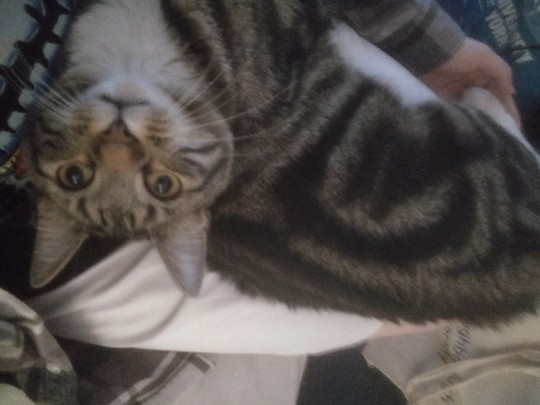#but not enough to know common coat variations besides like solid color vs tabby vs tuxedo kind of stuff
Note
As far as my favourite animals go, I am obligated to put my two silly baby tabby cars, Benny (image 2) and Jenny (image 1)


But my favourite animal is the peacock mantis shrimp. One creature should not have evolved to have such rage in its body. I'm not going to attach a photo cos it looks a bit strange and I wouldn't want to scare you without warning :D
Your crochet things are amazing! I love them so much! Have a great day!
Thank you!! Benny and Jenny are absolutely adorable, and I don't think I've ever seen a cat with side stripes quite like Benny's. It almost looks like he has a big square on his side? I admit I haven't spent much time with cats though so idk if that's a common cat thing lol
Peacock mantis shrimp are so cool! I appreciate you not wanting to scare me but as long as the animal photo isn't gory I have yet to encounter any animal pictures that scare me ^_^
#ask away!#some days require cute animal pictures#antignocchiphase#cats#I love cats but my dad is very allergic#so I love them from afar lol#I have spent enough time around cats to be decent at understanding their body language and to know how to pet them#but not enough to know common coat variations besides like solid color vs tabby vs tuxedo kind of stuff#animal pictures don't scare me but oh man the sounds walrus make when eating when they are out of the water???#absolutely horrifying! I mean really cool from a 'what is happening' kind of perspective#but I heard it as a child and it was one of those like...foundational things you can't pry out of your memory#I guess the emotion there wasn't really fear so much as like... the feeling of 'don't like that'
4 notes
·
View notes
Note
Is calico a possible Creasia coat color?
Ah, such a simple question, but so complicated to answer! Is it possible? Maybe. Likely to be expressed? No.
You probably know how calicos are produced and anyone who doesn't can google that. Short review: you need at least one of the color alleles (in the case of the domestic cat, the black/red) located on the X chromosome. So males are always homozygous, but females can be heterozygous. Then you need the thing where neither color is dominant. Instead, females express both colors. This event alone will produce a tortie, not a calico.
To get calico, you need one more thing: the piebald gene, which is present in many animals. It produces random colorless white patches, interspersed with the underlying color(s).
Finally, in order to get a classic calico, you need the female zygote to have discarded her extra Xs (turned them into bar bodies) early enough to produce solid patches instead of a more blended coat.
NOW you have a classic mi-ke calico. She will almost always be female, but can be male XXY or male chimera (having absorbed his twin!) or possibly an even rarer genetic event. On the flip side, solid red or black cats are male something like 75% of the time. Female solids would be homozygous for the trait, which is rarer.
There are other genes that effect cat coat color and pattern, and of course there can always be new mutations, but those are the basics.
Question: is color a sex-linked gene in other species of cats? Big cats have many things in common with domestic cats. Is this one of them? I could not find an answer to this. Probably no. But... I did have Caraca say at one point when she and Halvery were trying to reproduce Roup's color, "Solids are more likely to be male." This strongly suggests that some aspect of creasia color is on the X. So even if this is unlikely for big cats in our world, I have sort of committed to it on Lidian.
But... Is the piebald gene present in other cats besides domestic cats? Again, no answer.
The closest I could find was the white band gene that produces golden tabby tigers. It is not actually piebald, though. It's a completely different gene. If you read the wikipedia article about golden tabby tigers, you will notice a lot of inbreeding. This is how most usual colors in domestic (and semi-domestic) animals get a foothold. People notice a single unique mutation, decide they love it, and do some aggressive inbreeding to produce homozygous individuals. Many domestic animals have very shallow gene pools. Obviously, most of them handle it just fine.
Wild animals avoid inbreeding. Nature tends towards outbreeding. Maximizing genetic diversity is a survival strategy, so animals evolve various barriers to inbreeding.
There ARE more color variations in big cats that live in jungles/forests vs open plains. Tigers and leopards have more color variations than African lions. It doesn't seem to affect their odds of survival as much.
Creasia live in dense forest, so it makes sense that they have some color variation. Rare mutations would pop up, but they would quickly disappear unless the creasia started selecting for them. So if they decided that piebald was fabulously beautiful and everyone wanted to have babies with those cats, they might quickly develop a piebald trait that is regularly expressed. But they tend to like colors that are "good for hunting," and those are browns/grays/black. They are starting to value other traits and expand their tastes, though.
Anyway - the potential for something like a calico is probably in there somewhere. To specifically get calico, I think you'd see piebald popping up first.
#hunters unlucky#creasia#color genetics#color genetics in cats#anyone more knowledgeable is welcome to correct me if I have made mistakes
37 notes
·
View notes